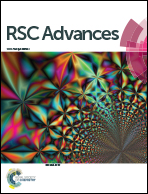Mechanistic study on the Cp*iridium-catalyzed N-alkylation of amines with alcohols†
Abstract
DFT calculations have been performed to study the mechanism of the N-alkylation of amines with alcohols catalyzed by [Cp*IrCl2]2 (Cp* = η5-C5Me5) in the presence of K2CO3. The energetic results show that this N-alkylation reaction proceeds via the hydrogen autotransfer mechanism and the catalytic cycle includes three sequential stages: (1) alcohol oxidation to produce aldehyde, (2) aldehyde–amine condensation to form an imine and (3) imine reduction to afford the secondary amine product. For stages 1 and 3, the most favorable pathways are the inner-sphere hydrogen transfer pathway under the catalysis of Cp*Ir(NHPh)Cl (C) and the inner-sphere hydrogen transfer pathway with KHCO3 as the proton donor. Thermodynamically, both stages 1 and 2 are endergonic, but stage 3 is highly exergonic. Thus stage 3 is the driving force for the catalytic cycle. The energetic span model has also been used to assess the catalytic cycle, and it is found that the turnover frequency-determining intermediate (TDI) and the turnover frequency-determining transition state (TDTS) are the 18e complex Cp*Ir(κ2-CO3K)Cl (A) and the transition state BC-TS5i for β-H elimination, respectively. The calculated turnover frequency (TOF), 4.68 h−1, agrees with the experimentally determined TOF and, therefore, provides strong support for the proposed catalytic cycle.


 Please wait while we load your content...
Please wait while we load your content...